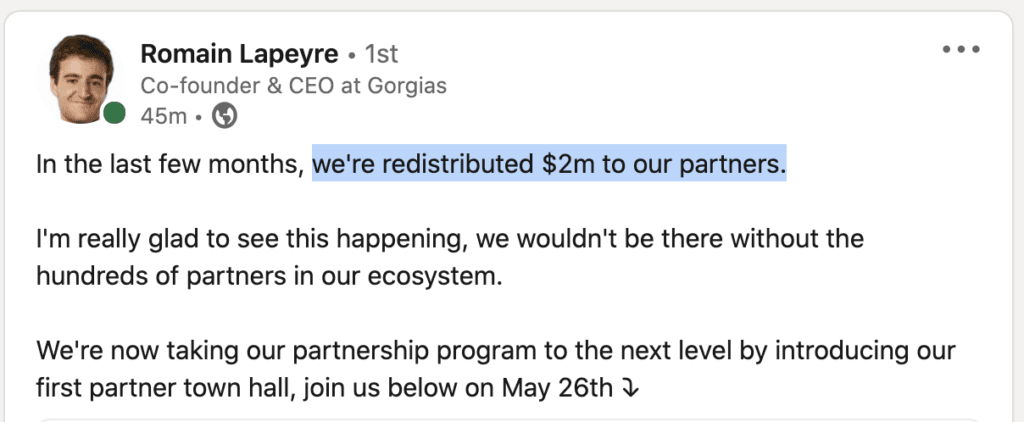This @HubSpot partner showed his dedication in ink! Thanks @daleksandersen pic.twitter.com/Niqf9JsYCx
— Brian Halligan (@bhalligan) April 27, 2022
Salesforce’s biggest source of new revenue isn’t CRM or even support. It’s partners and platform. And it has been since 2017 or so! Wow. But that took time. It took more than a decade after Salesforce was founded:
Shopify’s partner ecosystem is also huge, comprising 20% of its revenue in 2020. But it was only 8% in 2018. So while partners are just as critical to Shopify as they are to Salesforce … Shopify also waited a long time to deeply monetize them:
Partners are a key part of getting to $100m for most of us, and maybe even almost all of us at $1B in ARR. But they rarely get us to the first $1m … usually you are too small or nascent for anyone to really want to partner with you. And even once you are big enough for the Big Cos to want to partner with you — you are still likely not big enough for monetizing your own partners to be material. Yet.
In any event, partnerships almost always work. But our expectations of how quickly they deliver, and how they deliver, are almost always not met. 🙂
A few things to think about:
- Partnerships generally take years to produce material revenue. Invest long here. Take your existing sales cycle — and double it in terms of how long it will take to generate revenue from and with partners. You already know your customers and how to close them. Your partner? Even if the customers are joint, they’ll never know you and your product as well as you do. So of course it takes longer.
- Power laws and long tails are common in partnership programs. A few partners will drive the majority of joint deals and revenue … and then all the rest together generally are material only as a group. Try to leverage your API and self-service capabilities for the long tail if you can, and focus human resources on the ones that move the needle. More on that here.
- Ask yourself “Why?” Yes, everyone wants Salesforce, Google, Amazon, Shopify, etc. as a partner. But why would they partner with you? If you don’t know … they won’t. Having a cool tool is not reason enough. There are 1000s of startups any BigCo can and does partner with. Or even more. The easiest way to start is to bring them a few big deals. Yes, I know this sounds backward :). But if and when you do, you get noticed.
- Pay (commissions) twice. For most partner programs, you may have to pay commissions twice: to the partner, and again to your own sales / success team. Later, you can nuance this. But in the early and middle days, you just have to pay twice. Otherwise, your team and their team just won’t work together smoothly enough. It sounds expensive, and it is, but think about the payments to the partner as a marketing cost. You’ll see it’s hard to find as effective a marketing program as whatever you pay your partners.
- Double down on any partners you have early traction with. Because those are natural synergies. In the early days, invest heavily in any partners you have even 1 or 2 joint customers with. Invest in what is working. Just a few early joint customers almost always point to a future of many more. Sometimes, it can be hard to see why one partner gets more benefit from you than another. That’s fine, you’ll figure it out. But double down where the natural synergies are.
- Smaller partners with high affinity can often move the needle. Getting 1% of Slack’s or Salesforce’s customer base would be great. But what about 25% of a smaller, but fast-growing startup where the integration is even tighter? That might make you more money, and create more revenue, than a tiny attach rate to a big co. At a minimum, don’t discount the power of attaching to 10% of the customers of a smaller partner vs. 0.1% of the customers of a huge one. More on attach rates here.
- You need dedicated resources. Biz Dev, Channel Manager, whatever. You need dedicated resources to manage your partners, at least once you can afford them. And put them on quotas, generally … but ones they can achieve. If you don’t have someone full-time managing your partners, you won’t hit your goals here.
- You have to be a good sport. If your partner wants you to show up to their customer conference, join a Zoom, meet a prospect, or do a deal you don’t really want to do … you gotta do it. Remember, they are bringing you into a deal. That is risky. Don’t add risk to the deal for them. Sales reps will only bring customers into deals they know they can trust. Better not to bring the partner in at all, otherwise … no matter how good the solution itself.
Be patient. This stuff takes time. But it usually works.
A deep dive on all these learnings with the team at Gorgias, with over 6,000 customers on Shopify, a large percent from partners:
(note: an updated SaaStr Classic post)




